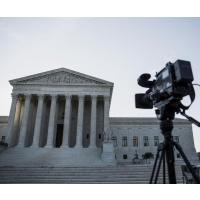Videotaping U.S. Supreme Court Arguments: Distorted Media Editing is Key Concern of Judges and Lawyers
 (photo: Drew Angerer, Bloomberg/Getty)
(photo: Drew Angerer, Bloomberg/Getty)
By Jack Bouboushian, Courthouse News Service
(CN) — Federal auditors warned that media distortion could outweigh the benefits to public education if the U.S. Supreme Court permitted video of oral arguments.
The findings appear in a May 31 report (pdf) by the Government Accountability Office. Though the Supreme Court posts audio recordings of oral arguments at the end of each week, it does not currently allow any video recording of proceedings before the bench.
Only two of the 13 federal courts of appeal — the Second and Ninth Circuits — allow video coverage of oral arguments, but 49 state supreme courts allow it.
A website for the federal court system notes that appellate courts are authorized to decide on their own whether to allow video recording in the courtroom.
The GAO report noted that the highest courts in Australia, Canada and the U.K. have policies that allow video coverage of cases.
As part of its investigation, the GAO interviewed 16 judges — including two U.K. judges — and nine attorneys about possible concerns related to video coverage of Supreme Court proceedings.
Few of those interviewed were concerned that video coverage would affect participants' behavior, privacy or security.
Instead, the majority of judges and attorneys who spoke to the GAO feared video coverage would result in the media distorting portions of the arguments, especially if a judge's statement is taken out of context.
Video-editing distortions of Supreme Court cases could be especially severe, due to the hotly disputed issues the high court handles.
Yet, many interviewees also said video coverage of Supreme Court proceedings would help educate the public about the judicial system, and that it could instruct law students and attorneys on how to conduct arguments.
It could potentially also increase understanding about the issues before the Supreme Court, and alleviate the public perception that the court is a partisan institution, attorneys told the GAO.
The GAO did not conclude its report with any recommendations, and the U.S. Supreme Court submitted no agency comments. However, the Supreme Court justices have traditionally opposed cameras in the courtroom.
An appendix to the report notes that few studies have been conducted on the effects of video coverage in appellate courts.
To Learn More:
U.S. Supreme Court: Policies and Perspectives on Video and Audio Coverage of Appellate Court Proceedings (U.S. Government Accountability Office) (pdf)
- Top Stories
- Unusual News
- Where is the Money Going?
- Controversies
- U.S. and the World
- Appointments and Resignations
- Latest News
- Musk and Trump Fire Members of Congress
- Trump Calls for Violent Street Demonstrations Against Himself
- Trump Changes Name of Republican Party
- The 2024 Election By the Numbers
- Bashar al-Assad—The Fall of a Rabid AntiSemite






Comments